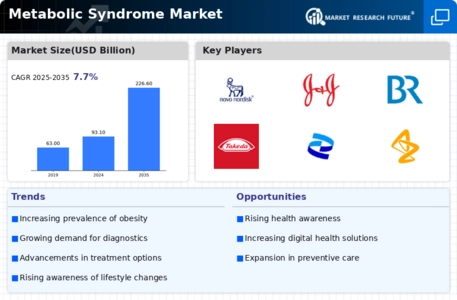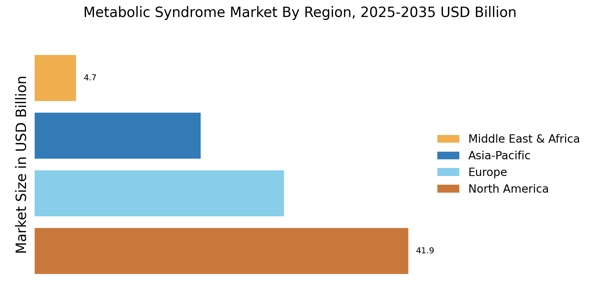Rising Prevalence of Metabolic Disorders
The increasing prevalence of metabolic disorders, such as obesity and diabetes, is a primary driver of the Metabolic Syndrome Market. According to recent data, nearly 34% of adults are classified as obese, which significantly heightens the risk of developing metabolic syndrome. This alarming trend is prompting healthcare providers and policymakers to prioritize interventions aimed at reducing the incidence of these conditions. As awareness grows, the demand for diagnostic tools and treatment options within the Metabolic Syndrome Market is expected to surge, leading to innovations in therapies and lifestyle management solutions. Furthermore, the economic burden associated with these disorders, estimated to reach billions annually, underscores the urgency for effective strategies to combat metabolic syndrome.
Growing Awareness of Lifestyle Modifications
There is a growing awareness of the importance of lifestyle modifications in managing metabolic syndrome, which serves as a key driver for the Metabolic Syndrome Market. Educational campaigns and public health initiatives are increasingly emphasizing the role of diet, exercise, and behavioral changes in preventing and managing metabolic disorders. This shift in focus is leading to a rise in demand for nutritional products, fitness programs, and wellness services tailored to individuals at risk of metabolic syndrome. As consumers become more health-conscious, the Metabolic Syndrome Market is likely to see an uptick in the adoption of preventive measures and lifestyle interventions, ultimately contributing to a reduction in the prevalence of metabolic disorders.
Policy Initiatives Supporting Metabolic Health
Policy initiatives aimed at promoting metabolic health are emerging as a significant driver of the Metabolic Syndrome Market. Governments and health organizations are increasingly recognizing the need for comprehensive strategies to address the rising rates of metabolic disorders. Initiatives such as subsidizing healthy food options, implementing taxes on sugary beverages, and promoting physical activity through community programs are gaining traction. These policies not only aim to reduce the prevalence of metabolic syndrome but also create a supportive environment for individuals to make healthier choices. As these initiatives take root, the Metabolic Syndrome Market is likely to benefit from increased public engagement and investment in health promotion strategies.
Technological Advancements in Treatment Options
Technological advancements are revolutionizing treatment options within the Metabolic Syndrome Market. Innovations in medical devices, such as continuous glucose monitors and wearable fitness trackers, are empowering patients to take control of their health. These technologies facilitate real-time monitoring of metabolic parameters, enabling timely interventions and personalized treatment plans. Additionally, advancements in telemedicine are enhancing access to healthcare professionals, allowing for more effective management of metabolic syndrome. As these technologies become more integrated into everyday healthcare practices, the Metabolic Syndrome Market is poised for growth, driven by the demand for more efficient and effective management solutions.
Increased Investment in Research and Development
Investment in research and development (R&D) is crucial for advancing the Metabolic Syndrome Market. Pharmaceutical companies and biotech firms are increasingly allocating resources to discover novel therapies and interventions for metabolic syndrome. This trend is evidenced by a significant rise in clinical trials focused on metabolic disorders, with hundreds of studies currently underway. The potential for breakthrough treatments not only enhances patient outcomes but also presents lucrative opportunities for stakeholders in the Metabolic Syndrome Market. As new findings emerge, the landscape of treatment options is likely to expand, fostering competition and innovation among market players. This investment climate is expected to drive growth and improve the overall efficacy of metabolic syndrome management.


















Leave a Comment